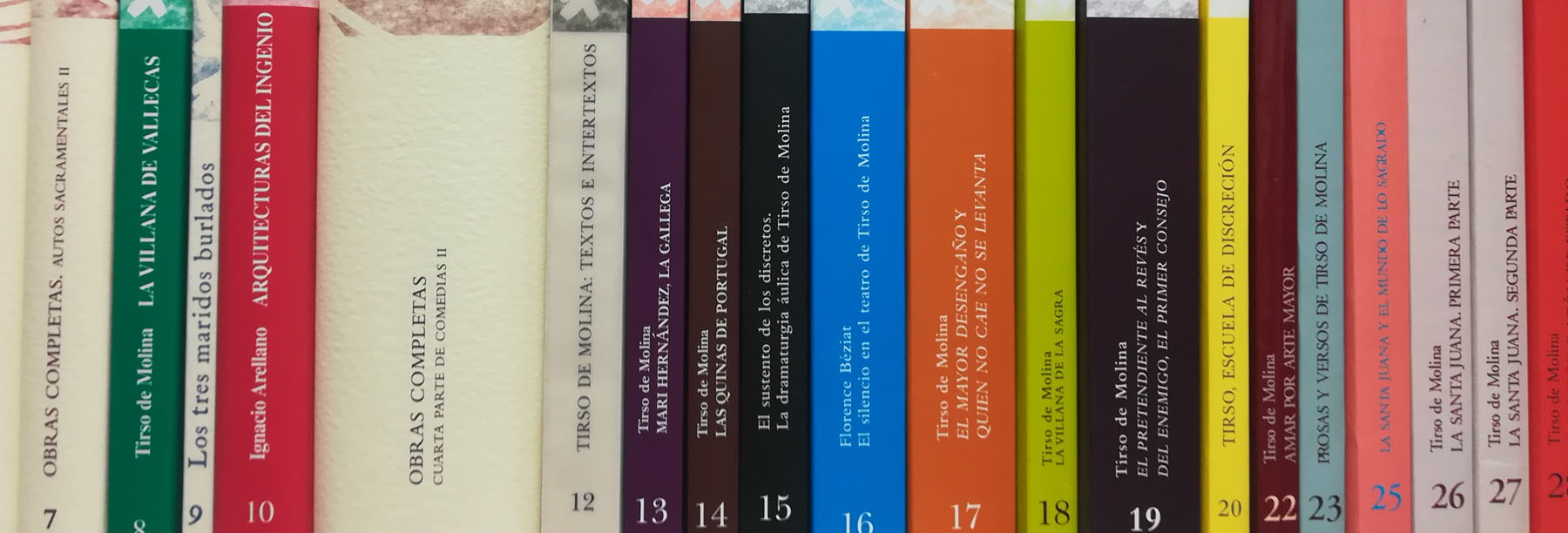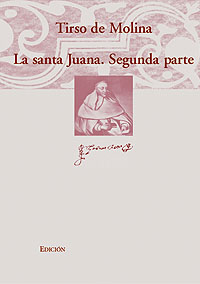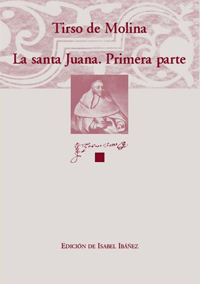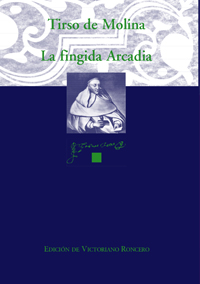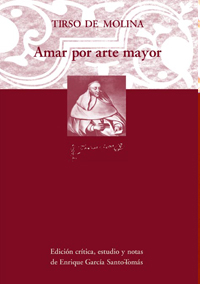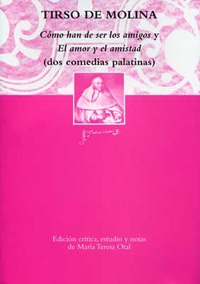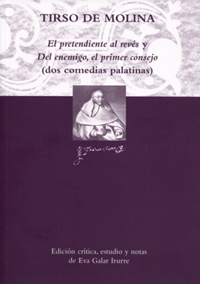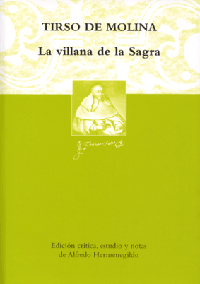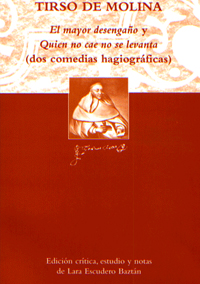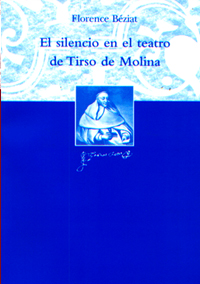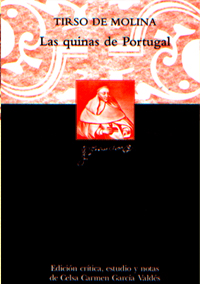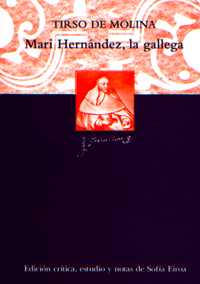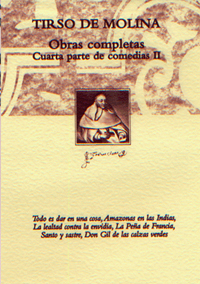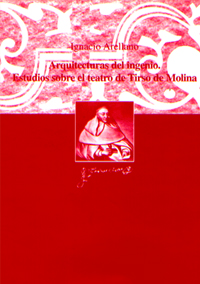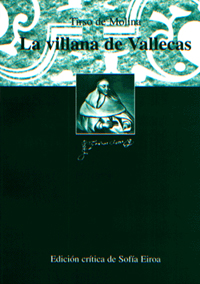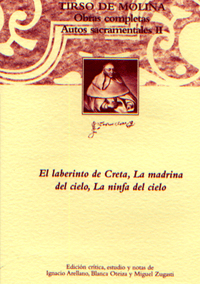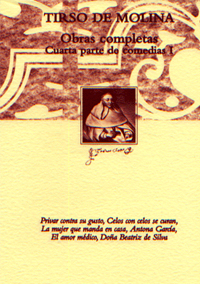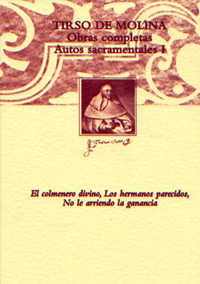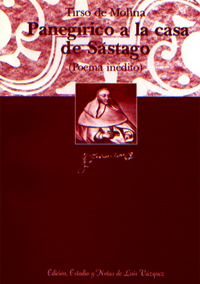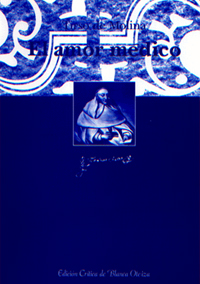Publications of high school of programs of study Tirsianos
Directors: Ignacio Arellano and Luis Vázquez
Sub-directed by: Blanca Oteiza
-
Florence Béziat
-
Laura Dolfi
-
Francisco Florit
-
Nadine Ly
-
Berta Pallares
-
Pilar Palomo
-
James A. Parr
-
Alan K. G. Paterson
-
Felipe B. Pedraza
-
Marc Vitse
The collection
download book
Tirso de Molina, 29
Saint Joan. Part Three
Edition by Isabel Ibáñez, Blanca Oteiza and Cristina Tabernero
Madrid/New York, high school de programs of study Tirsianos/high school de programs of study Auriseculares (IDEA)
2022
ISBN 978-1-952399-04-6
The only testimony we have of La santa Juana. Tercera parte (SJIII) is its manuscript (MS3) which is preserved together with those of the first two comedias in the BNE (Res 249). It is autograph except on a few occasions and its doctrinal content led to its non-publication in the Quinta parte de comedias , which thus consists of eleven comedias instead of the usual twelve that form a part. SJIII has by source Daza1613 as evidenced by the six references to this text in the margin against certain polemical episodes, some of them viciously censured.
From the manuscript, SJIII has been transmitted since the 19th century through copies and editions of different profile and interest, whose affiliation is not difficult: the almost palaeographic copy by Manuel Serrano y Sanz at the end of the 19th century, followed by the first edition by Cotarelo (1907), Blanca de los Ríos in 1946, Agustín del Campo (1948), Pilar Palomo (1970), the selection of corrections and amendments by Xavier Fernández (1991), and the edition by Consuelo Barrera in 1992.
The text of the comedy is accompanied by an exhaustive annotation of its many and varied folkloric, literary, historical-biographical, etc. references, and is preceded by an introductory study that analyses the MS3 manuscript in detail (intervening passages, scribes, graphic characteristics...), and the dramatic construction, which, as in the case of the previous parts, is characterised by generic hybridity and conditioned by the model of the comedia nueva, the hagiographic genre and the trilogy status of La santa Juana.
This publication is part of the project Edición crítica del teatro completo de Tirso de Molina. Cuarta fase (FFI2013-48549-P) of the Ministry of Economics and Competitiveness of the Spanish Government, directed by Blanca Oteiza, and of which the editors are part of the team researcher.
Tirso de Molina, 28
Love for the sake of the State
Edited by Francisco Sáez Raposo
Madrid/New York, high school de programs of study Tirsianos/high school de programs of study Auriseculares (IDEA)
2019
ISBN 978-1-938795-52-7
This is the first critical edition of Tirso's comedy Amar por razón de Estado, which has been at position by Francisco Sáez Raposo, who considers it a work of circumstances probably written on the occasion of the visit made in Madrid in October 1624 by Wolfgang William of Palatine-Neoburg, Duke of Clèves. In its edition various testimonies have been handled, such as the prince, on which the text is established(Doce comedias nuevas del maestro Tirso de Molina. Primera parte, Sevilla, Francisco Lyra, 1627); or, for the first time, the loose edition inserted in the Parte cuarenta y una de comedias de diferentes autores (Zaragoza, Pedro Escuer, 1646) in a copy owned by the Vatican Apostolic Library Services (call number R.G.Lett.Est.IV.278), in addition to the manuscript containing the comedy Sutilezas de amor, also known as El marqués del Camarín ( BNE, Ms. 16.665), a non-autograph copy that appears signed with a supposed signature of "El maestro Tirso de Molina", accompanied by a rubric, on January 1, 1637, and which is a reworking of Tirso himself, according to the information that it is possible to extract from the manuscript, to put it on the boards of a corral de comedias.
In the preliminary study, in addition to the aforementioned compositional circumstances of Amar por razón de Estado and its rewriting, with the corresponding textual study and metrical synopsis, other issues are analysed, such as the fact that it is "A comedy without a comedian", "The design of the space of the dramatic action" or "The themes on which the plot is built".
Tirso de Molina, 26
Saint Joan. Second part
Edition by Isabel Ibáñez, Blanca Oteiza, Cristina Tabernero and Lara Escudero
Madrid/New York, high school de programs of study Tirsianos/high school de programs of study Auriseculares (IDEA)
2018
ISBN 978-1-938795-45-9
As in the case of La santa Juana. Primera parte, the transmission of this second comedy began in the 17th century with the text of the manuscript of the trilogy (Library Services Nacional de España, Res 249) and of the princely edition in the Quinta parte de comedias del maestro Tirso de Molina (Madrid, Imprenta Real, 1636), copies of which have been preserved in the Library Services Nacional de España (Madrid), France (Paris) and Austria (Vienna).
This critical edition establishes the text according to the princely edition, duly checked against the manuscript, which, with respect to that of La santa Juana. Primera parte, has the particularity of not being autograph or bearing any date and being considerably shorter than the text of the princely edition, and with the twentieth-century editions begun by Emilio Cotarelo (1907) and to be followed to a greater or lesser extent by the other editors: Blanca de los Ríos (1946), Agustín del Campo (1948) and Pilar Palomo (1970). The proposals of Xavier Fernández in his 1988 edition of the manuscript have also been taken into account, where appropriate. The text of the comedy is accompanied by an exhaustive annotation of its many and varied folkloric, literary, historical-biographical and other references.
The comedy is preceded by an introductory study that analyses in detail its sources (Daza's biography of Sor Juana, Historia, vida y milagros, of 1610 and 1613) and the dramatic construction, conditioned by the model of the comedia nueva, the hagiographic genre and the trilogy condition of La santa Juana.
This publication is part of the project Edición crítica del teatro completo de Tirso de Molina. Cuarta fase (FFI2013-48549-P) of the Ministry of Economics and Competitiveness of the Spanish Government, directed by Blanca Oteiza, and of which the editors are part of the team researcher.
Tirso de Molina, 26
Saint Joan. Part One
Edited by Isabel Ibañez
Madrid/New York, high school de programs of study Tirsianos/high school de programs of study Auriseculares (IDEA)
2016.
ISBN: 978-1-938795-31-2
Between 1613 and 1614, although there was probably an earlier version, Tirso wrote the trilogy dedicated to Sister Juana de la Cruz - in the century Juana Vázquez (1481-1534) - a nun of the Franciscan Third Order Regular, whom Cisneros appointed parish priest of Cubas (the only known case of a woman). Her miraculous deeds meant that she was already considered a saint during her lifetime and that after her death preparations began to promote her cause with a view to her canonisation, which, however, came up against several obstacles that have paralysed it until the present day.
The trilogy is preserved in manuscript Res 249 at Library Services Nacional de España in Madrid. The first part is autograph and is dated and signed by Fray Gabriel Téllez in Toledo between 20 and 30 May 1613. The manuscript of the second part is neither dated nor autograph, but a copy in which two anonymous amanuenses intervened, which transcribes (although probably in an abbreviated form) the Tyrsian autograph now lost. And the third autograph part is again dated and signed by Téllez in Toledo in August 1614 between the 6th and 24th.
Years later the trilogy was published for the first time in the Quinta parte de comedias del Maestro Tirso de Molina (Madrid, Imprenta Real, at the expense of Gabriel de León, book merchant, 1636) with the singularity that it only includes the first and second parts of La santa Juana. This critical edition of La santa Juana. Primera parte, which will soon be followed by the publication of the remaining two parts, sets out the text according to the princely edition, duly collated with the manuscript and annotated in its many and varied folkloric, historical-biographical and other references. It also includes an introductory study that analyses in detail the dramatic sources, and the texts of the manuscript and printed trilogy.
Isabel Ibáñez is Professor of programs of study Iberian at the University of Pau and the Pays de l'Adour and a specialist in the work of Tirso de Molina. She has published more than thirty articles and edited several books in partnership and journals on various aspects of Golden Age theatre(Similitud y verosimilitud en el teatro del siglo de Oro. Vraisemblance et ressemblance dans le théâtre du Siècle d'Or espagnol, 2005; Persona y personaje: el Homo historicus y su puesta en speech en el Siglo de Oro, 2015; Pouvoirs et écritures. L'autre en question dans l'ère hispanique, Líneas, revue interdisciplinaire d'études hispaniques, 2011...).
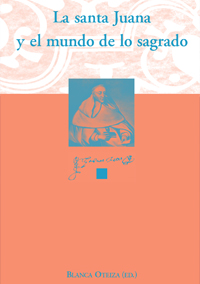
Tirso de Molina, 25
Saint Joan and the World of the Sacred
Edited by Blanca Oteiza
Madrid/Pamplona/New York, high school de programs of study Tirsianos/high school de programs of study Auriseculares
2016.
ISBN: 978-1-938795-30-5
The Issue gathers eighteen articles in three thematic blocks. An initial one of six works dedicated to the biobibliography of Sor Juana, both of the documents and circumstances related to her life as well as her literary recreations, with special attention to that of the Mercedario, ordered from the general to the particular (Blanca Oteiza, María Luengo, Isabel Ibáñez, Jesús M. Usunáriz, Alan Paterson, Concepción Martínez Pasamar and Cristina Tabernero). The second, somewhat broader, which reflects from different perspectives on the world of the sacred or the sacralization in Tirso's work, especially from its protagonists, mostly female, but not only (Ignacio Arellano, Isabelle Bouchiba, Paloma Fanconi, Miguel Galindo, Naïma Lamari, Philippe Meunier, Elena Nicolás, and Victoriano Roncero), and finally a third block that deals with various themes, motifs and characters of a religious nature in the work of contemporary Mercedario authors (Pablo Blanco and José Enrique Duarte, Lara Escudero and Teresa Rodríguez). The Issue closes the work by José Ángel Márquez, an updated look on the death of Tirso in Almazán.
This publication is part of the project Edición crítica del teatro completo de Tirso de Molina. Cuarta fase, reference letter FFI2013-48549- P, of the Spanish Ministry of Economics and Competitiveness, directed by Dr. Blanca Oteiza, administrative assistant of high school de programs of study Tirsianos (IET).
|
Table of contents |
Page |
| 9 |
|
Juana Vázquez, Sister Juana and the Saint Juana |
Page |
|
BLANCA OTEIZA |
15 |
|
MARÍA LUENGO |
37 |
|
ISABEL IBÁÑEZ |
49 |
|
JESÚS MARÍA USUNÁRIZ |
61 |
|
ALAN K. G. PATERSON |
83 |
|
CONCEPCIÓN MARTÍNEZ PASAMAR AND CRISTINA TABERNERO |
99 |
|
The world of the sacred in the work of Tirso de Molina |
Page |
|
IGNACIO ARELANO |
121 |
|
ISABELLE BOUCHIBA |
143 |
|
PALOMA FANCONI |
157 |
|
MIGUEL GALINDO |
169 |
|
NAÏMA LAMARI |
185 |
|
PHILIPPE MEUNIER |
199 |
|
ELENA NICOLÁS |
213 |
|
VICTORIANO RONCERO |
225 |
|
The religious world in contemporary authors |
Page |
|
PABLO BLANCO AND JOSÉ ENRIQUE DUARTE |
249 |
|
LARA ESCUDERO |
265 |
|
TERESA RODRIGUEZ |
281 |
|
The death of Tirso |
Page |
|
JOSÉ ÁNGEL MÁRQUEZ |
297 |
Tirso de Molina, 24
The pretence of Arcadia
Edited by Victoriano Roncero López
New York / Madrid / Pamplona, high school de programs of study Auriseculares (IDEA) / high school de programs of study Tirsianos (IET)
2016.
ISBN: 978-1-938795-19-0
Tirso de Molina wrote between mid-1622 and early 1623 La fingida Arcadia, a comedy that was first printed in the Parte tercera de las comedias del Maestro Tirso de Molina in 1634. The play belongs to the group group of comedias de enredo with a pastoral atmosphere and its action takes place in Valencia del Po (Italy). It is a magnificent example of the Mercedarian friar's exploration of the relationship between literature, theatre and reality. Drawing on the second part of Don Quixote and La Arcadia, a pastoral novel by Lope de Vega, Tirso writes about the pastoral love between the Countess Lucrezia, an Italian noblewoman, and Don Felipe Centellas, a captain in the Spanish army, who, disguised as shepherds, must overcome the obstacles that prevent their happiness. Also important is the homage paid to Lope de Vega and his theatrical formula.
Victoriano Roncero López, Full Professor of Spanish Literature of the Golden Age at Stony Brook University. He is the author of books on Quevedo's humanism, his theory and historiographical practices and on the topic of laughter in the Spanish picaresque novel. He has edited the cancioneril poetry of the 15th century, that of Fernando de Herrera, Quevedo's muse Clío and an anthology of satirical burlesque poetry of the Golden Age (the latter two with Ignacio Arellano). He has also edited El buscón and El tribunal de la Justa Venganza, as well as two autos sacramentales by Calderón. He is director of Hipogrifo. Journal of literature and culture of the Golden Age and of the Batihoja collection of high school of programs of study Auriseculares (IDEA).
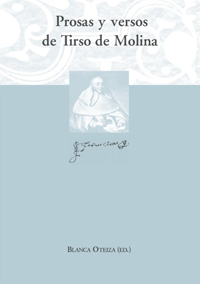
Tirso de Molina, 23
Prose and verse by Tirso de Molina
Edited by Blanca Oteiza
Madrid / Pamplona / New York, high school de programs of study Tirsianos / high school de programs of study Auriseculares
2015.
ISBN: 978-1-938795-04-6
Prosas y versos de Tirso de Molina brings together fourteen articles on the Mercedarian's prose, poetry and theatre: Nathalie Dartai and Laura Dolfi deal with the miscellany Cigarrales de Toledo and Deleitar aprovechando, and Luis Vázquez with Historia general del Orden de Nuestra Señora de las Mercedes; Paloma Fanconi and Blanca Oteiza, with the function of the poetry inserted in the novels Los triunfos de la verdad and La patrona de las musas del Deleitar aprovechando. His theatre is also the object of study from new and updated perspectives: skill author versus poet (Isabel Ibáñez), the poetics of reading La fingida Arcadia ( Naïma Lamari) or the rewriting of Esto sí que es negociar ( Carola Sbriziolo); the name and its poetics (Philippe Meunier) or the ethics and aesthetics of insults (Isabelle Bouchiba); characters, from Don Juan (Felipe Pedraza) to Achilles (Enrique Rull), and dramatic motifs around jealousy (Ana Suárez), or the palatial spaces of village and palace (Francisco Sáez Raposo) complete these pages.This publication is part of the project Edición crítica del teatro completo de Tirso de Molina. Fourth phase, reference letter FFI2013-48549-P, of the Spanish Ministry of Economics and Competitiveness, directed by Dr. Blanca Oteiza, administrative assistant of high school de programs of study Tirsianos (IET).
Tirso de Molina, 22
Loving by greater art
Edited by Enrique García Santo-Tomás
New York / Madrid / Pamplona, high school de programs of study Auriseculares (IDEA) / high school de programs of study Tirsianos (IET)
2015.
ISBN: 978-1-938795-01-5
This is the Tirsian comedy Amar por arte mayor, which is included in the Quinta parte de comedias del Mercedario (Madrid, Imprenta Real, 1636).
The critical edition has been carried out by the University of Michigan professor Enrique García Santo-Tomás, a specialist in golden literature and author of works such as La musa refractada: literatura y óptica en la España del Barroco ( 2014), Modernidad bajo sospecha: Salas Barbadillo y la cultura material del siglo XVII (2008), Espacio urbano y creación literaria en el Madrid de Felipe IV (2004) or La creación del 'Fénix': recepción crítica y training canónica del teatro de Lope de Vega (2000). He has also edited texts by Lope(Arte nuevo de hacer comedias, Las bizarrías de Belisa), Tirso de Molina(Don Gil de las calzas verdes), Salas Barbadillo(Don Diego de Noche, La hija de Celestina)... on Chair .
Tirso de Molina, 21
How Friends Should Be and Love and Friendship (two Palatine comedies)
Edited by María Teresa Otal
Madrid-Pamplona, high school de programs of study Tirsianos
2007.
ISBN: 978-84-95494-24-5
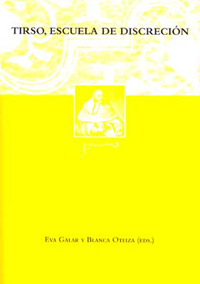
Tirso de Molina, 20
Tirso, school of discretion
Edited by Galar, E. and Oteiza, B.
Madrid-Pamplona, high school de programs of study Tirsianos
2007.
ISBN: 84-95494-19-1
The Issue that we present now, the 20th in the collection, gathers the interventions of the congress of Tirso de Molina: his time and influences, organized by the Institute of Romance Languages and Literatures of the University of Copenhagen and the GRISO of the University of Navarra, and held in the Danish capital in May 2006.
|
Table of contents |
Page |
|
7 |
|
|
FREDERICK A. DE ARMAS |
9 |
|
CARLOS CABANILLAS |
27 |
|
EVA GALAR |
51 |
|
JUAN P. GIL-OSLÉ |
71 |
|
JULIUS JENSEN |
87 |
|
JOSÉ MORALES SARAVIA |
101 |
|
BLANCA OTEIZA |
119 |
|
BERTA PALLARES |
139 |
|
LUIS VÁZQUEZ |
161 |
|
MIGUEL ZUGASTI |
181 |
Tirso de Molina, 19
The Upside Down Pretender and Of the Enemy, the First committee (two Palatine comedies)
Critical edition, study and notes by Eva Galar Irurre
Madrid-Pamplona, high school de programs of study Tirsianos
2005
ISBN: 84-95494-17-5
El pretendiente al revés and Del enemigo, el primer committee are two Palatine comedies, which reflect the Neoplatonic currents of the time on love and friendship, the Tridentine provisions on marriage or the ideas of the treatise writers of the time at purpose on power or privanza... And all this with the optimism characteristic of the Mercedario's comic production, where the witty word shines and the tangle leads the characters through a distant, smiling and understanding universe in which mistakes can be corrected.
Tirso de Molina, 18
The villain of La Sagra
Edited by Alfredo Hermenegildo
Madrid/Pamplona, high school de programs of study Tirsianos
2005.
ISBN: 84-95494-16-7
Tirso de Molina, 17
El mayor desengaño and Quien no cae no se levanta (Two hagiographic comedies)
Critical edition, study and notes by Lara Escudero Baztán
Madrid-Pamplona, high school de programs of study Tirsianos
2004.
ISBN: 84-95494-15-9
El mayor desengaño and Quien no cae no se levanta are Tyrsian hagiographic comedies, the first critical edition of which was the focus of the author's doctoral thesis thesis . The choice was based on an interest staff in this genre and its multiple relations with disciplines such as Art, History and Theology, and also because of the singularity of these two comedies: The peculiar structure of El mayor desengaño and the inclusion of a theological civil service examination are relevant; in Quien no cae no se levanta, a kind of cloak-and-dagger comedy, a return to the divine, the treatment of the comedy stands out (it includes an entremés within the comedy), which moves away from the conventional moulds of the genre in the Mercedario, and contrasts with the conceptual seriousness of El mayor desengaño.
Tirso de Molina, 16
Silence in the theatre of Tirso de Molina
Edited by Florence Béziat
Madrid-Pamplona, high school de programs of study Tirsianos
2004.
ISBN: 84-95494-12-4
The purpose of this work has been to study the different manifestations of silence in Tirso de Molina's theatre. First of all, we identified the plays that showed the non-performance of an enunciative act, those that revealed a moment of silence, a moment in which the word ceased to be uttered, totally or partially. After selecting some twenty plays, whether tragic or comic, they were grouped according to their dominant topic : holiness, power, honour and love. The aim was above all to determine as clearly as possible - as far as the classic mix of genres in Golden Age theatre allows - the exact conditions, the specific field, the status, the environment in which a word was not exercised, or had ceased to be exercised, in order to be able to establish, finally, whether the manifestations of silence, on the one hand, and its values, on the other, differed according to the genre, tragic or comic, of the play studied.
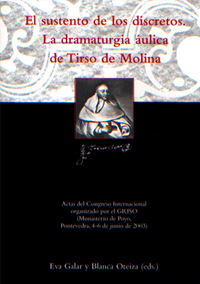
Tirso de Molina, 15
The sustenance of the discreet. The classroom dramaturgy of Tirso de Molina
Edited by E. Galar and B. Oteiza
Madrid-Pamplona, high school de programs of study Tirsianos
2003.
ISBN: ISBN 84-95494-11-6
Tirso de Molina, 14
The quinas of Portugal
Edition by C. C. García Valdés
Madrid-Pamplona, high school de programs of study Tirsianos
2003.
ISBN: ISBN 84-95494-09-4
Celsa C. García Valdés has dealt with Las quinas de Portugal, a comedy that reflects the creation of the Portuguese nation in the midst of the reconquest. Tirso wisely interweaves historical-miraculous events and warlike actions in a comedy of "Moors and Christians", which Celsa C. García Valdés studies and comments on with clarity and scientific rigour. She analyses the two surviving manuscripts (one of them signed by Tirso himself in 1638) and the modern editions of this work, to offer a refined and suitably annotated text.
Tirso de Molina, 13
Mari Hernández, the Galician
Edited by Sofía Eiroa
Madrid-Pamplona, high school de programs of study Tirsianos
2003.
ISBN: 84-95494-08-6
Sofía Eiroa, the editor of this "villanesque comedy", in her introduction, examines the textual transmission and dramatic values of the play. The entanglement is based on the love affair between the villainess who gives degree scroll to the comedy and the Portuguese Count Don Álvaro, who has to flee to Galicia because he has been falsely accused of betraying his king, Don Juan II of Portugal. The rural landscapes of Galicia serve as framework for the ingenious and courageous actions of Mari Hernández.
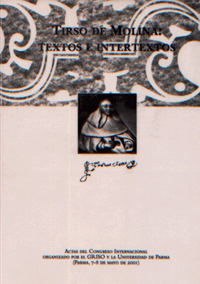
Tirso de Molina, 12
Tirso de Molina: Texts and Intertexts
Edition by L. Dolfi and E. Galar
Madrid-Pamplona, Instituto de programs of study Tirso de Molina.
2001.
ISBN: 84-95494-06 X
The present Issue collects the conference proceedings of the International congress organized by the GRISO and the University of Parma (Parma, May 7-8, 2001), focused on investigating the results of the "report" of Tirso de Molina (trying to find out which elements of his cultural heritage had passed into his plays and in what way) and to point out the traces that, in turn, Tirso's comedies had left in other successive plays.
Following this duplicitous flow of report and without any purpose of exhaustiveness, we have brought together these two different perspectives under the unifying degree scroll Tirso de Molina: textos e intertextos.
Tirso de Molina, 11
Complete works. Fourth part of comedies II: Todo es dar en una cosa, Amazonas en las Indias, La lealtad contra la envidia, La Peña de Francia, Santo y sastre and Don Gil de las calzas verdes.
Edited by the IET, directed by I. Arellano
Madrid-Pamplona, high school de programs of study Tirsianos
2003.
ISBN: 84-95494-03-5
The fourth part of Tirso's comedies includes the "Trilogía de los Pizarros" (Todo es dar en una cosa, Amazonas en las Indias, and La lealtad contra la envidia, ed. by M. Zugasti), La Peña de Francia ( ed. by L. Vázquez), Santo y sastre ( ed. by J. Garau) and Don Gil de las calzas verdes (ed. by I. Arellano). Authoritative scholars of Tirso dedicate some introductory pages to the comedies, in which they underline key aspects, and make a great effort in the textual fixation and annotation of places that present greater difficulty.
Tirso de Molina, 10
Architectures of wit. programs of study on the theatre of Tirso de Molina
Edited by Ignacio Arellano
Madrid-Pamplona, high school de programs of study Tirsianos
2001.
ISBN: 84-95494-05-1
Ignacio Arellano offers those interested in Tirso de Molina's theatre the opportunity to bring together in this book all his excellent articles, scattered since 1984 in specialised magazines. The articles are varied and cover a wide range of topics: he offers the intro-ductions to his editions of Marta la piadosa and Don Gil de las calzas verdes; he explores the spheres of power and social and political morality in the dramatic universe of the Mercedarian (La república al revés); or analyses an area little explored by critics, the union of religion and comedy in the autos sacramentales (El colmenero divino, Los hermanos parecidos, No le arriendo la ganancia, El laberinto de Creta, La ninfa del cielo, La madrina del cielo), which is completed with comments on the scenography of the comedies of saints. At summary an essential tool for anyone who wants to delve into the dramatic universe of Tirso de Molina.
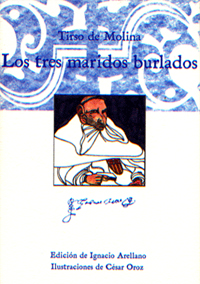
Tirso de Molina, 9
The three mocked husbands
Edited by Ignacio Arellano
Madrid-Pamplona, high school de programs of study Tirsianos
2001.
ISBN: 84-95494-04-3
Edition of a small masterpiece by Tirso to celebrate the fifth anniversary of the IET (high school de programs of study Tirsianos) in 2001. This short novella, inserted in Cigarrales de Toledo, is probably the story most likely to appeal to the modern reader, with its perfect arrangement of three mockeries: three women who mock, through their wit, their three husbands. The witty mockery will at no point damage the honour of the mocked. At final, the novel presents, once again within Tirso's universe, the exhibition of his wit and the technique of mockery. The edition also features amusing illustrations by César Oroz that make it even more enjoyable to read.
Tirso de Molina, 8
The villain of Vallecas
Edited by Sofía Eiroa
Madrid-Pamplona, high school de programs of study Tirsianos
2001.
ISBN: 84-95494-02-7
Continuing with the excellent work of editing Tirso de Molina's comedies carried out by the IET (high school de programs of study Tirsianos) of the University of Navarra and the Mercedarian Order, the editor Sofía Eiroa presents us with a rigorous introduction, a refined and carefully annotated text of La villana de Vallecas, a comedy less well known than Marta la piadosa or Don Gil de las calzas verdes, but equally interesting from a dramatic point of view. In its almost 4000 verses, the protagonist, Doña Violante, will create increasingly entangled situations in order to recover her honour and love for Don Pedro de Mendoza. The comedy ends happily thanks to its wit... and to Tirso's mastery.
download book
Tirso de Molina, 7
Complete works. Autos sacramentales by Tirso de Molina, II: El laberinto de Creta, La madrina del cielo, La niunfa del cielo.
Edited by Ignacio Arellano, Blanca Oteiza, Miguel Zugasti
Madrid-Pamplona, high school de programs of study Tirsianos
2000.
ISBN: 84-95494-01-9
These three autos have been considered as "attributed" or "attributable". Of El laberinto de Creta and La madrina del cielo there are, according to the editors, insufficient reasons not to give them to Tirso; however, La ninfa del cielo has less guarantee of authenticity. Nevertheless, they are published here with the conviction that they deserve at least a more careful edition, a path for further research.
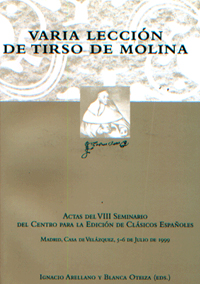
Tirso de Molina, 6
Varia lección de Tirso de Molina (conference proceedings del VIII seminar del Centro para la Edición de Clásicos Españoles)
Edition by Ignacio Arellano and Blanca Oteiza
Madrid-Pamplona, Instituto de programs of study Tirsianos
2000.
ISBN: 84-923453-8-1
From the partnership between the Centro para la Edición de Clásicos Españoles (CECE), the Instituto de programs of study Tirsianos (IET) and the Casa de Velázquez, the VIII seminar of the CECE, Tirso de Molina and "El burlador de Sevilla", whose conference proceedings are collected here, was held in July 1999.
|
Table of contents |
Page |
|
7 |
|
|
IGNACIO ARELLANO |
9 |
|
LAURA DOLFI |
31 |
|
FRANCISCO FLORIT |
65 |
|
WILLIAM F. HUNTER |
85 |
|
BLANCA OTEIZA |
99 |
|
ALAN K. G. PATERSON |
129 |
|
JOSÉ Mª RUANO |
143 |
|
LUIS VÁZQUEZ |
163 |
|
GERMAN VEGA |
177 |
Tirso de Molina, 5
Complete works. Fourth part of comedies by Tirso de Molina, I: Privar contra su gusto, Celos con celos se curan, La mujer que manda en casa, Antona García, El amor médico, and Doña Beatriz de Silva.
Edited by the IET, directed by I. Arellano
Madrid-Pamplona, high school de programs of study Tirsianos
1999.
ISBN: 84-923453-4-9
The text of the comedies is preceded by a presentation that focuses on the most interesting dramatic and literary aspects, and examines the textual status . The preliminary study is not intended to be exhaustive, but rather to constitute a guide or an outline to point out the key aspects of each work, according to the vision of each publisher and the characteristics of each play.
Tirso de Molina, 4
Complete works. Autos sacramentales by Tirso de Molina, I: El colmenero divino, Los hermanos parecidos, No le arriendo la ganancia, El colmenero divino, Los hermanos parecidos, No le arriendo la ganancia.
Edited by Ignacio Arellano, Blanca Oteiza and Miguel Zugasti.
Madrid-Pamplona, high school de programs of study Tirsianos
1998.
ISBN: 84-923453-3-0
Critical edition of three autos sacramentales whose authorship is undisputedly Tirso's, and which represent an interesting Degree of structural elaboration in the path of training of the autos from Lope to Calderón.
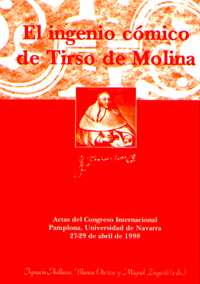
Tirso de Molina, 3
conference proceedings of congress International The comic wit of Tirso de Molina
Edition by Ignacio Arellano, Blanca Oteiza and Miguel Zugasti
Madrid-Pamplona, high school de programs of study Tirsianos
1998.
ISBN: 84-923453-2-2
Specialists from a number of international universities take a wide range of approaches to the comic world of Tyrsian theatre.
Tirso de Molina, 2
Panegyric to the house of Sástago (Unpublished poem)
Edition, study and notes by Luis Vázquez
Madrid-Pamplona, high school de programs of study Tirsianos
1998.
ISBN: 84-923453-1-4
An unpublished poem whose edition is presented by P. Vázquez with a prologue that clarifies the circumstances of the text and a style with ambitious resources and a very elaborate Gongorine tone.
Tirso de Molina, 1
Medical love
Critical edition by Blanca Oteiza
Madrid-Pamplona, high school de programs of study Tirsianos
1997.
ISBN: 84-920005-7-0.
Interesting palace comedy in which the protagonist is rewarded for her intellectual aspirations when she brilliantly obtains a Chair in medicine and the position of royal doctor.

